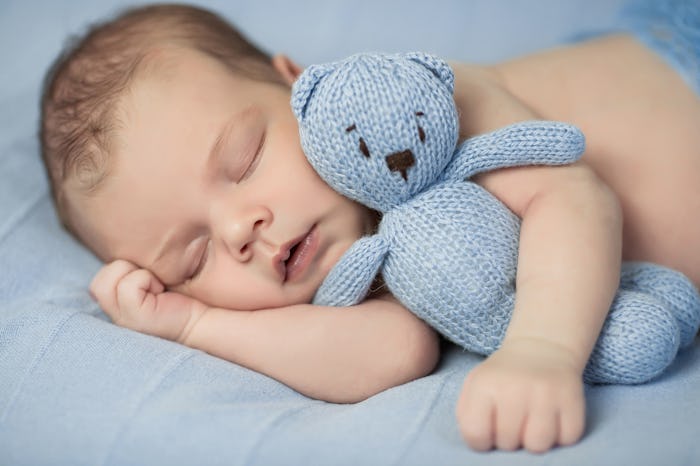Life

7 Surprising Things You're Teaching A Child When You Give Them A Lovey
A lovey is an item your child has come to associate with comfort. It could be a blanket, stuffed animal, or favorite toy, all used to help transition from one developmental stage to another. There are some surprising things you're teaching a child when you give them a lovey that you might not be aware of, too, because what the lovey represents goes far beyond its physical attributes.
According to The Baby Sleep Site, the best age to introduce a lovey is at least 4 months of age, but waiting until your baby is 6- to 9-months-old is arguably a better way to go. The wait, according to the same site, is due to safety concerns. If the lovey has moving parts or pieces that could come undone, it's always better to wait until your baby is old enough to keep those things away from their mouth. In fact, the American Pregnancy Association (APA) recommends keeping all comfort objects, including blankets and pillows, out of the crib until your baby is at least 1-year-old, to reduce the risk of Sudden Infant Death Syndrome (SIDS). And while there are a number of other factors that can contribute to an unsafe sleep environment — like overheating, bed-sharing, or low birth weight — having a crowded crib can be problematic and dangerous.
Dr. Ari Brown, M.D., co-author of Baby 411, tells Today.com that giving your baby a lovey around six months is OK if the toy is "no bigger than the size of her head and has no removable eyes or buttons," adding that your baby should also be moving and rolling on his or her own first. Regardless of when you give in and let your baby have a comfort item, there's definitely some things you're teaching them, including the following:
How To Self-Soothe
Some babies learn how to self-soothe early on by thumb-sucking, while others prefer the comfort of a soft blanket or friendly-looking stuffed toy. Dr. George Askew of Zero to Three — National Center for Infants, Toddlers, and Families — says that a transitional object used to self-soothe indicates a strong child-parent bond. This is because your child uses the lovey for love and attention when mom or dad isn't there.
How To Fall Asleep
Consistently using the lovey can actually help your baby learn to fall asleep. If they have something in their sleep environment they've come to rely on, and trust, they're more likely to go to sleep without the comfort and trust provided by their parents. Kim West, a baby and child sleep expert known as The Sleep Lady, says that a blankie, or other type of lovey, is a great replacement for having your baby cry it out, or having mom or dad rush in to the rescue.
Compassion For Others
Dr. Alan Greene, pediatrician and Chief Medical Officer for uBiome, says that allowing your child to have a lovey may spark more creative, imaginative play, relieve stress and worry, and help your child with separation anxiety. By using the comfort item to help themselves feel better, they're more likely to show compassion to others when they're in need of comfort, too.
Responsibility
Having a special toy or blanket your child doesn't want to lose track of means learning how to be responsible, and at a relatively young age. Some parents might, according to Parents, buy several of the same lovey in order to switch them out regularly, or in case one is lost. But for the most part, expect the lovey to be by your child's side often. That means they'll either take great care of it, knowing where that one beloved stuffed bear is at all times, or learn the consequences of losing it.
Independence
Believe it or not, being so attached to an inanimate object may help your child become more independent. According to BabyCenter, because a lovey is considered a transition object that eases fears and anxiety, it gives your child that little kick of confidence needed to venture off and explore the world without you.
How To Control Emotions
Growing up is hard work, you guys. There's so much to learn and understand, so it's an emotional experience, to say the least. Thankfully, relying on a blanket or favorite toy may help your child learn how to process their emotions. Dr. William Sears, pediatrician and author of over 30 parenting books, says that not only is it healthy for your child to have a lovey as long as necessary, it helps them form stronger, deeper bonds with others which is an important emotional quality to develop.
How To Interact With People
Even adults have go-to security items (phones, anyone?) to alleviate social pressures or internal anxieties. Why should children be any different? By having that ratty blanket at every outing, you're showing your child how to interact and be around other people. It's OK if they need to consult with their lovey, and check-in emotionally, before dealing with the world at large. And it's OK to cling to the object that makes them feel most comfortable when they'd otherwise be anxious. In time, that object allows them to open up to others.
Check out Romper's new video series, Romper's Doula Diaries:
Watch full episodes of Romper's Doula Diaries on Facebook Watch.